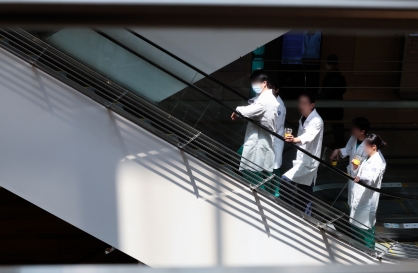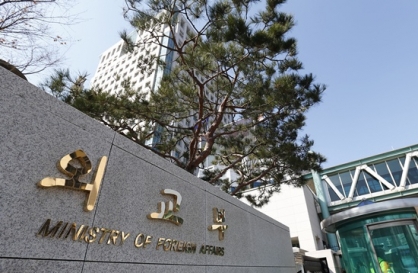KOICA helps Myanmar cope with effects of climate change
By Shin Hyon-heePublished : June 15, 2016 - 16:56
BAGAN, Myanmar -- Endless rows of yellow-green, tender young trees soughed in the breeze, churning out rustling sounds across a serene forest in Bagan, Myanmar.
A 10-minute walk led to a more exuberant section where taller and lusher eucalyptuses, neems and acacias towered on the backdrop of a mountain.
The once barren land is turning into a greener neighborhood for the agrarian residents thanks to assistance from the Korea International Cooperation Agency.
A 10-minute walk led to a more exuberant section where taller and lusher eucalyptuses, neems and acacias towered on the backdrop of a mountain.
The once barren land is turning into a greener neighborhood for the agrarian residents thanks to assistance from the Korea International Cooperation Agency.

Since 1998, the state grant aid provider has been carrying out an extensive reforestation program in four phases around the Southeast Asian country’s arid central regions to help fight climate change and desertification.
During a two-day visit from June 8, the forests brimmed with a variety of trees at different heights, dependent on their planting periods. The eucalyptuses bedded during the 2004-05 second stage appeared as tall as 5 meters.
“Due to the program, agricultural yield has gone up, the overall living environment has improved and people here had more job opportunities for planting and watering trees,” said U Ba Kaung, director of the Dry Zone Greening Department at the Ministry of Natural Resources and Environmental Conservation.
“These areas are barren soil, but if you can compare with the past, the change is clear -- you can see it clearly even via Google images.”
About 9.2 percent of Myanmar’s territory, or 68,000 square meters, faces increasingly severe desertification, affecting some 15 million people, according to KOICA.
The situation has been accelerated by not only global warming, but also decades-old poverty, which prompted rampant logging by residents seeking to make a living.
Throughout the four phases, the agency has funneled in $428 million to plant about 900,000 trees across 840 hectares, the equivalent of 1,200 football fields.
Yet the program hit a snag during the initial period, as residents went on to cut around 60 percent of the trees down soon after the completion to feed their animals and for other household and commercial uses.
To prevent further losses, KOICA began to educate local officials and residents on forest management and conservation as they started the second stage, while digging and repairing wells in more than 10 villages and providing wood-saving ovens to some 5,800 households. The survival rate for the trees now hovers around 99 percent, officials said.
The Myanmar government, for its part, set up the greening department within the ministry, and laid out a six-phase, five-year comprehensive reforestation framework in 2001 that extends through 2031.
“It’s good that there is more grassland so that I can feed my cows easier, and for myself, I’ve been working here planting and watering,” said Tin Tin Hla, a 27-year-old villager.
“Since they installed an oven at home in November 2014, we’ve been able to save around 40 percent of firewood than before. It’s also good for health because it has a separate chimney.”
As most of the planting work has been finished, KOICA is now providing postmanagement training, seeking to hand over the forests to the Myanmar government in August.
With Myanmar’s political, economic and administrative reforms kicking into high gear, the agency plans to scale up its assistance focusing on transferring Korea’s development experiences. Among the key areas are sustainable rural development, capacity building in public service, industrial technology education and infrastructure establishment.
“In the past, there were lots of bare mountains in Korea as a product of not only the Korean War, but also poverty, but we have managed to restore forests through a well-designed 30-year state program. That’s what we’re trying to pass over to Myanmar,” said Kim In, KOICA’s senior vice president.
“I think Myanmar is the last treasure house with potential to become the next Vietnam. Despite our relatively small aid scale compared to the U.S., China or Japan, we have experience in eradicating poverty, so we should capitalize on this.”
By Shin Hyon-hee (heeshin@heraldcorp.com)
Korea Herald Correspondent
During a two-day visit from June 8, the forests brimmed with a variety of trees at different heights, dependent on their planting periods. The eucalyptuses bedded during the 2004-05 second stage appeared as tall as 5 meters.
“Due to the program, agricultural yield has gone up, the overall living environment has improved and people here had more job opportunities for planting and watering trees,” said U Ba Kaung, director of the Dry Zone Greening Department at the Ministry of Natural Resources and Environmental Conservation.
“These areas are barren soil, but if you can compare with the past, the change is clear -- you can see it clearly even via Google images.”
About 9.2 percent of Myanmar’s territory, or 68,000 square meters, faces increasingly severe desertification, affecting some 15 million people, according to KOICA.
The situation has been accelerated by not only global warming, but also decades-old poverty, which prompted rampant logging by residents seeking to make a living.
Throughout the four phases, the agency has funneled in $428 million to plant about 900,000 trees across 840 hectares, the equivalent of 1,200 football fields.
Yet the program hit a snag during the initial period, as residents went on to cut around 60 percent of the trees down soon after the completion to feed their animals and for other household and commercial uses.
To prevent further losses, KOICA began to educate local officials and residents on forest management and conservation as they started the second stage, while digging and repairing wells in more than 10 villages and providing wood-saving ovens to some 5,800 households. The survival rate for the trees now hovers around 99 percent, officials said.
The Myanmar government, for its part, set up the greening department within the ministry, and laid out a six-phase, five-year comprehensive reforestation framework in 2001 that extends through 2031.
“It’s good that there is more grassland so that I can feed my cows easier, and for myself, I’ve been working here planting and watering,” said Tin Tin Hla, a 27-year-old villager.
“Since they installed an oven at home in November 2014, we’ve been able to save around 40 percent of firewood than before. It’s also good for health because it has a separate chimney.”
As most of the planting work has been finished, KOICA is now providing postmanagement training, seeking to hand over the forests to the Myanmar government in August.
With Myanmar’s political, economic and administrative reforms kicking into high gear, the agency plans to scale up its assistance focusing on transferring Korea’s development experiences. Among the key areas are sustainable rural development, capacity building in public service, industrial technology education and infrastructure establishment.
“In the past, there were lots of bare mountains in Korea as a product of not only the Korean War, but also poverty, but we have managed to restore forests through a well-designed 30-year state program. That’s what we’re trying to pass over to Myanmar,” said Kim In, KOICA’s senior vice president.
“I think Myanmar is the last treasure house with potential to become the next Vietnam. Despite our relatively small aid scale compared to the U.S., China or Japan, we have experience in eradicating poverty, so we should capitalize on this.”
By Shin Hyon-hee (heeshin@heraldcorp.com)
Korea Herald Correspondent




![[Weekender] Korean psyche untangled: Musok](http://res.heraldm.com/phpwas/restmb_idxmake.php?idx=644&simg=/content/image/2024/05/02/20240502050841_0.jpg&u=)


![[Eye Interview] 'If you live to 100, you might as well be happy,' says 88-year-old bestselling essayist](http://res.heraldm.com/phpwas/restmb_idxmake.php?idx=644&simg=/content/image/2024/05/03/20240503050674_0.jpg&u=)









![[Herald Interview] Director of 'Goodbye Earth' aimed to ask how we would face apocalypse](http://res.heraldm.com/phpwas/restmb_idxmake.php?idx=652&simg=/content/image/2024/05/03/20240503050732_0.jpg&u=)
